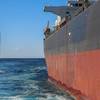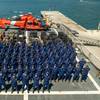Container shipping lines are in danger of putting future port investment at risk in their demands for terminal handling cost reductions, according to the recently launched Ports and Terminals Insight report published by global shipping consultancy Drewry.
Terminal operators face a “perfect storm” of rising costs due to bigger ships, greater business risks from larger liner alliances, softening global demand growth and pressure on terminal handling prices from cash-strapped carriers.
The financial results of listed port and terminal operators reveal a weakness in organic earnings amid escalating debt levels. Stricter cost rationalisation and financial risk reduction will be necessary to retain investment interest.
Companies with growth plans are commanding a significant market premium amid diminishing profitability. The market valuation of listed operators remains weak, underlining the cautious assessment of growth in the sector. Drewry’s Port Index, a market weighted assessment of share price performance of the top listed operators, slumped 10% in the last quarter.
Resisting downward pressure on terminal handling prices will be challenging, but not impossible, as much depends on local market conditions and the extent of choice for ever larger ships and alliances.
In a stark warning to container shipping lines Drewry’s senior analyst for ports and terminals Neil Davidson said: “Shipping lines need to be careful how they play the situation. If the returns from investing in and operating terminals fall too far, or the risks become too high (or both), then terminal operators may simply stop investing.”
However, there are some active steps that terminal operators can take to find their way through the storm.
According to the new report, they can focus on organic growth hotspots such as South Asia and the Middle East or they can buy market share through acquisitions. South Asia is set to be a star performer in relative terms, with its manufacturing industry likely to take some of the activity previously carried out in China.
And in the Middle East, major infrastructure projects are expected to resume after a hiatus caused by the low oil price. Buying market share through acquisitions in an attempt to outperform market growth is a strategy already being pursued by several port groups including Cosco Shipping Ports, China Merchants Port Holdings and Yildirim Group (Yilport Holdings), all of which have made recent high-profile acquisitions.
But many terminal operators still face a challenging future in the face of rising costs, pricing pressure and increasing risks after years of plenty.
“Our modelling shows that terminal operators will have to live with between 10% and 20% higher opex and capex costs due to bigger ships,” continued Davidson. “Risk is also increasing due to larger alliances, but also because horse trading on port choices between alliance members means that decision making is not necessarily logical.”













